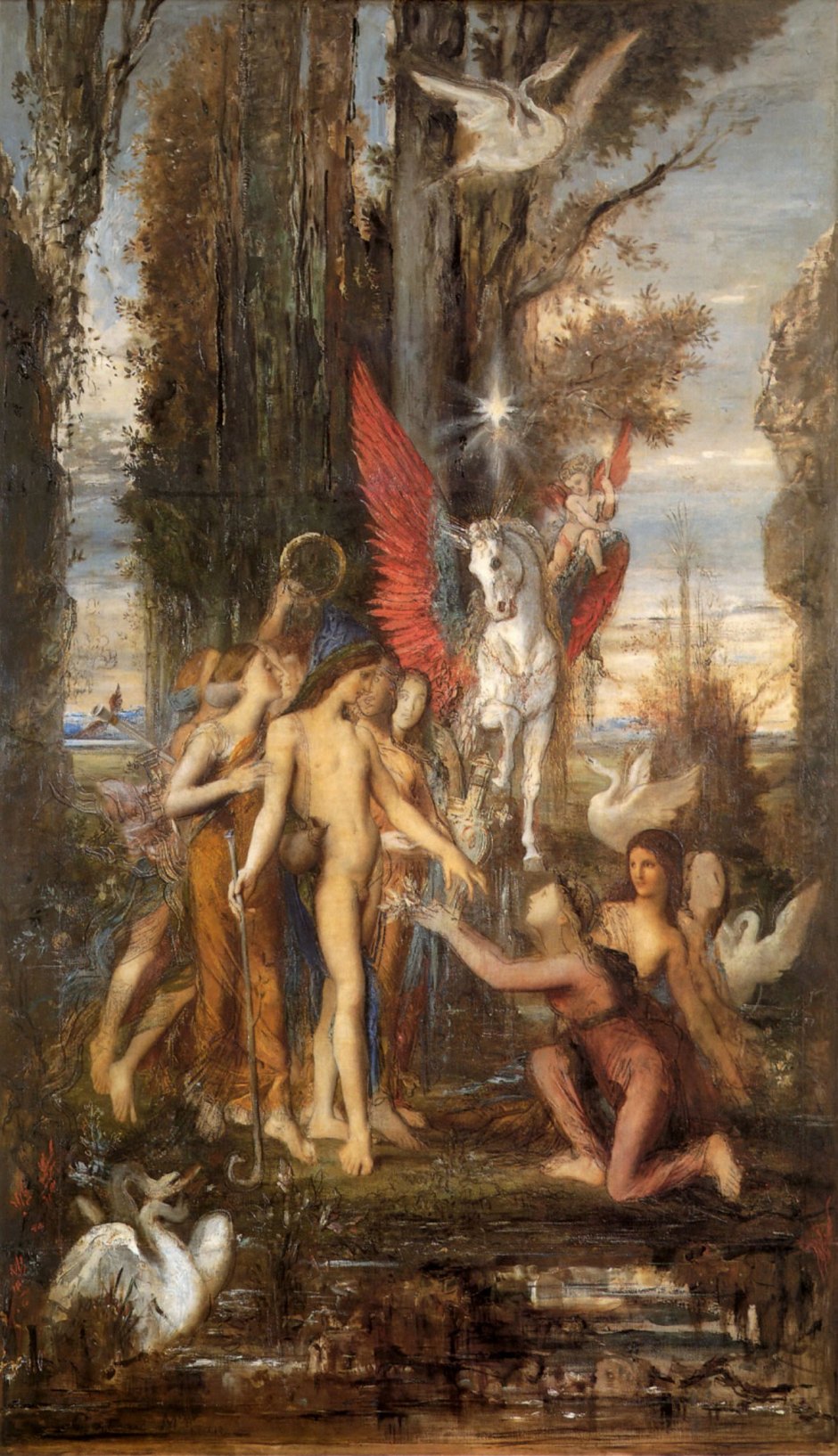Although I have yet to see any horse with wings, they were prominent in the past, both in classical mythology and in Renaissance literature. They fall into two main categories: Pegasus and hippogriffs. I’ll consider them in that order, and add a couple of outliers at the end.
Pegasus

The original myth of Pegasus is that he was born from Medusa’s blood shed when Perseus beheaded her. This is shown almost diagrammatically in Edward Burne-Jones’ gouache study in his unfinished Perseus Series. The Death of Medusa I from 1882 shows Perseus holding Medusa’s head aloft, as the winged horse and his more obscure sibling Chrysaor are born from her blood. The latter is shown as the associated person, without his characteristic curved golden sword.
In the classical legend of Perseus, he then flies off in his winged sandals, leaving Pegasus; during the Middle Ages a variant arose, in which Perseus flies off on Pegasus instead. Early artists therefore tended to paint the rest of the Perseus myth without any winged horse. This changed after the Renaissance, when the later variant became dominant in narrative art.
Before Pegasus became embroiled in the Perseus myth, he was most frequently shown in paintings of the Muses. This association arose from a different myth, which may also be of post-classical origin, that the horse made his way to Mount Helicon where the Muses had gathered to sing. This was because wherever Pegasus’ hooves struck the earth, the hoofmarks turned into springs. The mountain was so enraptured by the sound of the Muses singing that it was in danger of swelling, so Poseidon (the father of Pegasus) sent the horse there to relieve the pressure in the ground with a convenient spring.

By the time that Rubens came to paint Perseus and Andromeda in about 1622, the newer revised version including Pegasus seems to have become popular. Andromeda is at the left, unchained from her rock where she had been placed as a delightful morsel for the sea monster Cetus, which has here just been killed by Perseus and now lies at the lower edge with its fearsome mouth wide open. Perseus is in the process of claiming Andromeda’s hand as his reward, for which he’s being crowned with laurels. Although he clearly flew in on Pegasus, he is still wearing his winged sandals, and holds the polished shield reflecting Medusa’s face and snake hair.

The association between Pegasus and the Muses was revived in one of Gustave Moreau’s ‘new’ history paintings, of Hesiod and the Muses in 1860. This is the first of a series of works in which he shows Hesiod, generally considered to be the first written poet in the Western tradition to exist as a real person. He is shown to the left of centre, as a young man holding a laurel staff in his right hand. The Muses are squeezed in together, and one is on her knee to present Hesiod with a laurel wreath.
There are four swans on the ground, and one in flight above Hesiod, a winged Cupid sat on the left wing of Pegasus, and a brilliant white star directly above the winged horse. However, the Cupid and Pegasus were only added in about 1883, when the canvas was extended.
Some artists have shown Pegasus in roles outside classical mythology.

Eleanor Fortescue-Brickdale’s Love and his Counterfeits (1904) is a watercolour that she exhibited at the Royal Academy in 1905, accompanied by a text written by the artist explaining the allegorical scenario as that of a girl’s soul (at the left) awakening to receive love. She doesn’t recognise him at first, seeing instead Fear in black armour, and Romance as a boy on a bubble with a miniature castle of dreams. He leads Ambition, who rides on Pegasus, following which is Position. Then comes Pity, with a cup of tears with three handles. Later comes Flattery with a mirror, and Gratitude, and finally True Love, at the far right.
Hippogriffs
The name hippogriff, or hippogryph, reveals that it’s a composite of horse (‘hippo’) and griffin, itself a composite of eagle and lion. Although references to this beast are scant, it seems likely that it was intended to have the head and wings of an eagle, and the body and hindquarters of a horse, but some have turned it into a winged horse like Pegasus instead. In Western culture and art, the hippogriff is best known through its starring role in Ludovico Ariosto’s epic poem Orlando Furioso, where he describes it as being a cross between a mare and a griffin, which would at least give it an eagle’s wings and the body of a horse.

Girolamo da Carpi must have read Ariosto’s description soon after its publication in 1516-1532, and gives his image of the beast substantial wings. Its head doesn’t look particularly aquiline though, neither is this just another Pegasus. He shows an episode in Orlando Furioso in which one of the epic’s supporting heroes, Ruggiero, flies in on a hippogriff to rescue the heroine Angelica, in a story closely modelled on the myth of Perseus and Andromeda, with which it can sometimes be confounded.
Others

A winged horse plays a role in Pierre Puvis de Chavannes’ Fantasy from 1866, which he painted as a reaction against the popular trend towards realism. Two naked people of indeterminate gender are in an idyllic wooded landscape near the foot of sheer cliffs. One sits plucking flowers to form a wreath, the other uses a length of ivy to ‘train’ a winged white horse. In almost every respect, this was the antithesis of social realism, pre-Impressionist landscapes, and Academic painting.

That isn’t the case with Edward Robert Hughes’ first work showing a valkyrie from Norse mythology, in Dream Idyll (A Valkyrie) from 1902. In this erotic fantasy a naked and unarmed woman rides a winged horse in the sky over a late Victorian city, perhaps London.

